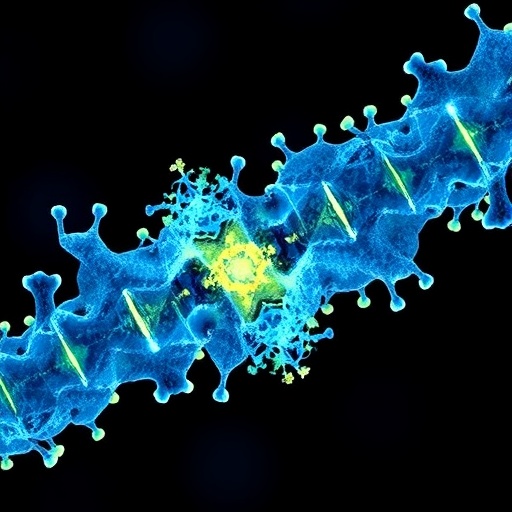In the ever-evolving battle against cancer, researchers continue to seek smarter, more targeted strategies to harness the body’s own immune system. A groundbreaking development unveiled by Hsu, Tang, Mendes, and colleagues showcases a next-generation approach that combines chemical ingenuity with immunotherapy: the creation of a tumour-specific STING agonist through a sophisticated two-component prodrug system. This ingenious design promises to overcome longstanding challenges in selectively activating the immune response directly within tumour tissues, sparing healthy areas and reducing systemic toxicity.
At the heart of this innovation lies the STING (Stimulator of Interferon Genes) pathway, a pivotal player in the innate immune system’s antiviral and antitumour responses. Activating STING in tumour cells triggers a cascade leading to the production of interferons and other cytokines, amplifying immune surveillance and promoting tumour destruction. However, STING agonists have traditionally suffered from poor selectivity and systemic side effects, limiting their therapeutic utility. The research from Hsu et al. addresses this critical limitation by engineering a prodrug system that specifically ‘switches on’ the STING activator exclusively in the tumour microenvironment.
The core concept hinges on a two-component design: one molecular fragment acts as a latent STING agonist, locked in an inactive state, while the other component functions as a tumour-responsive trigger. Together, they form a covalent prodrug conjugate, which remains inert in circulation but undergoes specific enzymatic cleavage or chemical transformation only in tumour cells. This biochemical specificity is achieved by exploiting unique enzymatic activities or microenvironmental conditions characteristic of cancerous tissues, such as elevated reductive potential or overexpressed proteases.
To engineer such a sophisticated prodrug, the team synthesized a novel STING agonist scaffold modified with cleavable linkers sensitive to tumour-associated triggers. These linkers preserve the molecule’s inert state during systemic circulation, thereby minimizing off-target immune activation. Upon reaching the tumour site, elevated levels of particular enzymes or reductive molecules trigger the cleavage of the linker, releasing the active STING agonist in situ. This targeted release mechanism enhances local immune activation, recruits cytotoxic T cells, and promotes innate immune signaling precisely where it is most needed.
Characterization of the prodrug system involved meticulous in vitro and in vivo assays to confirm selective activation and efficacy. Cellular studies demonstrated minimal STING pathway stimulation in normal cells but robust activation within various tumour cell lines. Pharmacokinetic analyses revealed prolonged circulation stability, mitigating premature degradation. Animal models bearing established tumours treated with the two-component prodrug exhibited significant tumour regression without the systemic toxicities usually associated with traditional STING agonists.
Mechanistically, the released STING agonist engages the cytosolic receptor STING, leading to the activation of downstream signaling cascades involving TBK1 kinase and IRF3 transcription factor. This results in enhanced interferon-beta production and pro-inflammatory cytokine secretion, which together amplify dendritic cell maturation and effector T-cell priming. The researchers further showed that this local immune stimulation synergizes with immune checkpoint inhibitors, suggesting that the prodrug system could serve as a potent adjuvant in combination immunotherapy regimens.
The implications of this work extend beyond cancer immunotherapy. By demonstrating that prodrugs can be rationally designed to respond to tumour-specific cues with high precision, this platform offers a versatile blueprint for delivering various immunomodulatory agents with enhanced safety profiles. This modular approach may be adapted to other pathways and therapeutic targets where selectivity and controlled activation are paramount.
Despite its promise, translating this two-component prodrug system from bench to bedside will require additional optimization. Scaling up synthesis, ensuring consistent tumour-targeting in diverse human cancers, and comprehensive safety studies will be critical next steps. Nonetheless, the versatility and elegance of the chemical design offer a compelling new avenue to unlock the full potential of STING-based immune therapies.
This innovation comes at a time when the field of cancer immunotherapy is rapidly pivoting toward combination strategies and personalized medicine. The ability to harness and amplify localized immune responses with minimal collateral damage could revolutionize how oncologists approach treatment-resistant and immunosuppressive tumours. Ultimately, the two-component prodrug may reframe existing paradigms by transforming STING activation from a blunt systemic trigger into a finely tuned molecular scalpel.
From a chemical biology perspective, the design principles elucidated by Hsu and colleagues exemplify the power of integrating molecular targeting with biological specificity. The delicate balance of stability versus reactivity in vivo is achieved through inquisitive linker chemistry tethered to an immunologically effective payload. This represents a tour de force of medicinal chemistry married with immunology, highlighting the multidisciplinary nature of next-generation cancer therapeutics.
Moreover, the researchers’ approach to exploiting tumour microenvironment characteristics underscores the broader trend of context-dependent therapy. By leveraging biochemical disparities unique to malignant tissues, such strategies promise safer and more effective drugs. The two-component prodrug system stands as a testament to how a deeper understanding of tumour biology can be translated into tangible chemical solutions with clinical potential.
As preclinical data continue to emerge, questions arise about the scope of tumour types amenable to this therapy and its integration with existing immunomodulatory agents. Future iterations may incorporate even more sophisticated triggers, such as hypoxia or pH-sensitive moieties, or combine multiple therapeutic payloads for synergistic action. Regardless, the current achievement marks a landmark moment in the field of targeted immunotherapy.
In sum, the tumour-specific STING agonist delivery system crafted by Hsu et al. represents a dazzling fusion of chemistry and immunology. It opens a promising pathway toward safer, more precise activation of the immune system against cancer, illuminating new dawns in the war against this relentless disease. As the scientific community eagerly awaits clinical translation, this work shines as a beacon of innovation, exemplifying how smart chemical design can empower the immune system’s own weapons with unprecedented precision.
Subject of Research: Tumour-specific STING agonist synthesis via a two-component prodrug system for targeted cancer immunotherapy
Article Title: Tumour-specific STING agonist synthesis via a two-component prodrug system
Article References:
Hsu, NS., Tang, C., Mendes, R.V. et al. Tumour-specific STING agonist synthesis via a two-component prodrug system.
Nat. Chem. (2025). https://doi.org/10.1038/s41557-025-01930-9
Image Credits: AI Generated




